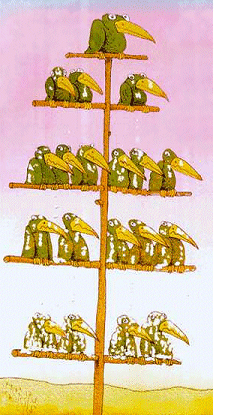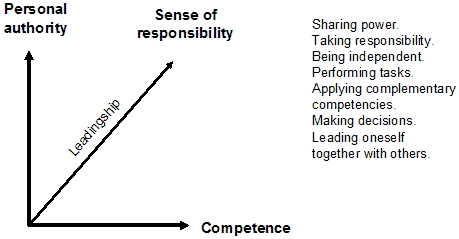Why is the nature of “leading” so decisive in the relationships between people at work? In search of a reasonable explanation, Rune Kvist Olsen* looks at what we are doing and thinking when we perform the process of “leading”.
The vertical relationship
 We find the first examples of the conceptualization of “leading” in the late 19th century. During this period of industrialization, the “leader-centered” model emerged on the workplace stage, and was referred to as “leadership”. The term was then adopted into common usage and incorporated in the English language. The core element in leadership was the concept of command and control between leaders and followers. The leader should lead, and followers should be led. This autocratic line of force was strictly based on a downward relationship between master and servant, and was characterized by a culture of domination, obedience and subservience from top to bottom. During the post-industrial period of the 20th century, numerous subsidiary leadership theories emerged, and books on leadership became popular. One such was the enormously influential “Scientific Management” by Fredrick Taylor (1911). In the years that followed the concept of leadership was further developed and interpreted. We might say that it evolved from a concept concerning actions directed by a leader to one of interaction between leader and followers.
We find the first examples of the conceptualization of “leading” in the late 19th century. During this period of industrialization, the “leader-centered” model emerged on the workplace stage, and was referred to as “leadership”. The term was then adopted into common usage and incorporated in the English language. The core element in leadership was the concept of command and control between leaders and followers. The leader should lead, and followers should be led. This autocratic line of force was strictly based on a downward relationship between master and servant, and was characterized by a culture of domination, obedience and subservience from top to bottom. During the post-industrial period of the 20th century, numerous subsidiary leadership theories emerged, and books on leadership became popular. One such was the enormously influential “Scientific Management” by Fredrick Taylor (1911). In the years that followed the concept of leadership was further developed and interpreted. We might say that it evolved from a concept concerning actions directed by a leader to one of interaction between leader and followers.
| “Moving out of our present mental box of reality perception will lead us on the way of changing our conception of reality. Remaining inside our mental box will confirm our existing perceptions of reality, and continue to preserve and protect our valid reality conceptions from change”. |
This evolution was accompanied by a transition from the sole focus on leader-as-superior, with followers as tailing instruments, to relationships characterised by interconnected actions and reactions between leader and followers. Within this modernizing frame of leadership, this more humane aspect emphasized cooperation, collaboration and coordination between people and work processes.
From the 1930s the Human Relations movement was established as a management discipline, and contributed to developing new perspectives in the organization of work. For example, working-teams were developed as an organizational form, and were further modified from the 1960s onwards, through the movement of socio-technical systems.
We find an example of contemporary leadership theory in Joseph Rost’s “Leadership for the Twenty-First Century” (1991). Rost holds that leadership is a relationship of influence between leaders and followers. Participants practise this influence in one way or another, even where actors in the relationship are not equal. According to Rost, leadership contains four elements:
(1) Relations based on influence;
(2) Leaders and followers;
(3) Both groups intending real change;
(4) Intended changes reflecting their mutual purposes.
 Again, the a priori belief that Rost and other leadership scholars have shared is that leadership is based on relationships characterised by leaders and followers, organized vertically, with the leader above and the followers below.
Again, the a priori belief that Rost and other leadership scholars have shared is that leadership is based on relationships characterised by leaders and followers, organized vertically, with the leader above and the followers below.
The term leadership, and the thinking and practice that surrounded it, developed an increasingly broad scope during the last century. Nevertheless, these main features in the relationship were sustained. Attempts to distance the term from its “leader-centred” origin, and to lend it a more equalized and mutualised image, have not changed the underlying substance of leadership:
1. The position of the leader above (to lead) and the followers below (to be led) is preserved and protected as an indisputable de facto, as if it were a law of nature.
2. The relationship between the leader and follower is unequally balanced, with the leader having the authority to decide over the followers, and the followers obliged to follow imposed decisions.
3. The relationship, regulated through leadership, is vertically organized from top to bottom, in accordance with the order of hierarchical ranking.

Horizontal relationships
In an effort to develop an alternative model of leading, a work-in-process began some years ago, seeking to develop a model based on equally-balanced relationships in the workplace. The term “leading-ship” was introduced into this debate by myself in 2006(1). The neologism was considered necessary because the term “leadership” had become so laden with associations, assumptions, perceptions and beliefs that yet another modified interpretation could never help establish a qualitatively new model. If real change were necessary, I felt it must involve a reorientation of language and terminology as well — a paradigm shift to help make the unthinkable thinkable, the unconceivable conceivable. The term leading-ship embodies the function of leading through personalized and internalized processes that involve every person in the workplace. Put simply, leading-ship consciously manifests itself as a contrast to leadership.
Leading-ship is: “…the expression of freedom and trust exercised by the individual human being as an autonomous person. “Leader-ship” is, on the contrary, the expression of subjugation to a superior authority in control of the individual human being as a subordinated person.”(2)
 Leading-ship acknowledges the people’s rights to self-direction within their respective field of work. It involves people using their will-power and work-power in contributing to common goals, whether alone or together with others. The participative character of leading-ship establishes and maintains values of personal influence, involvement, engagement and encouragement — critical factors in motivating creativity, productivity and efficiency. Self-determination is the main outcome of leading through participation, with the individual making self-directed decisions within his or her own area of responsibility.
Leading-ship acknowledges the people’s rights to self-direction within their respective field of work. It involves people using their will-power and work-power in contributing to common goals, whether alone or together with others. The participative character of leading-ship establishes and maintains values of personal influence, involvement, engagement and encouragement — critical factors in motivating creativity, productivity and efficiency. Self-determination is the main outcome of leading through participation, with the individual making self-directed decisions within his or her own area of responsibility.
The significance of leading-ship hinges around power-sharing. This, through competence-based authority, enables people to become empowered leaders through their actions in their respective workplaces. With people in charge of their own leading processes, they are able to assume responsibility for themselves and share responsibilities with others in the workplace community.
Leading-ship requires that people are treated on the basis of their personhood – as unique and equal individual human beings – as opposed to being treated according to position and rank. Leading-ship enforces a system whereby people are self-organized through a structure that acknowledges and grants individuals the right to work and function in a sovereign and autonomous manner. This self-organized structure will provide and ensure equal and mutual access to personal freedom and individual independence.
Leading-ship in practice amounts to “getting things done through oneself in collaboration with others”. The model of leading-ship is therefore based on two principles:
a. The right to lead one self;
b. The duty to support each other in the leading of themselves.
The outcome of leading-ship in the workplace is that everyone in the organization gets their work done through independent and responsible actions as equal members and partners of the organizational community. In such a process people are treated as the persons they are, not as the persons others have decided they should be.
Horizontal relationships are therefore based on the construction of the following elements:
1. Everyone in the workplace is leading themselves, in concert with others.
2. Relationships between people are equally balanced by the personal authority everybody is assigned to make decisions within their own sphere of responsibility
3. The relationships generated through leadingship are horizontally organized, consisting of people on the same level operating on mutual understandings.

Definitions and models
In my paper “Leadingship vs Leadership” (2009) an illustration of the terminology was presented. The model and definition of leading-ship is as follows:
The model:
The definition:
Leading-ship refers to the function of leading in the process of joining personal authority and individual competence throughout the performance of work. The individual person is leading him/herself in equal and mutal understanding with others through a shared conception of reality in the workplace. Everyone is a leader within their respective area of responsibility, and has the power to make individual decisions and to influence decisions concerning their respective field of work.

In contrast, the model and definition of leadership are as follows:
The model:
The definition:
Leadership refers to leadership as a person/people. The leader with superior rank is assigned the task of command and control in leading the inferior subordinates to follow the imposed orders. The subordinates await orders as followers in the cause of performing their work when responsibility is given from above. The subordinates perform servantship in obedience to their leader.
Conclusion
Leadership has been conceived and defined as a relationship between those above and below on a hierarchical ladder. This vertical relationship is an inherently authoritarian system, whereby a person in a higher position is assigned authority to make decisions regarding those below. Leading-ship is predicated upon relationships between equals and peers, and interaction is carried out without position or rank. Leading-ship is an egalitarian system, with dignity the core value in shaping power relationships between people in the workplace.
We have two main choices to our disposal. These are presented in the following models:
Authoritarian power system:
- Vertical power structure (high and low positions)
- Hierarchical organizational structure (someone above, as superior, and someone below, as subordinate)
- Leadership (leader-based work processes)
- Vertical relationship (somebody is leading and somebody is led)
Egalitarian power system
- Horizontal power structure (side-lined functions)
- Egalitarian organizational structure (everyone has independent and responsible roles)
- Leading-ship (individual-based and collective-based work processes)
- Horizontal relationship (the individual person leads, together with others)
“You never change things by fighting
the existing reality. To change
something, build a new model that
makes the existing model obsolete”.
– Buckminster Fuller
 *Rune Kvist Olsen is a member of the New Unionism Network and a lecturer, consultant, designer and author. At the University at Tromsø, Norway, he lectured in competency and organizational development. Prior to this he was a senior consultant at Kvaerner Energy, Oslo and a lecturer/consultant in private academies in developing, teaching and managing education programmes. He has published extensively in this area, his works including:
*Rune Kvist Olsen is a member of the New Unionism Network and a lecturer, consultant, designer and author. At the University at Tromsø, Norway, he lectured in competency and organizational development. Prior to this he was a senior consultant at Kvaerner Energy, Oslo and a lecturer/consultant in private academies in developing, teaching and managing education programmes. He has published extensively in this area, his works including:
- “The DemoCraticWorkplace – Empowering People (demos) to Rule (cratos) their own Workplace. Organizing Individual and Group Decision Processes through Personal Competence-based Authority”. 2009
- “The Equal Organizational Concept. A Theoretical Framework in developing the Equal Dignity Organization.”. The New Workplace Reality Series, 2008.
- “A change from leadership (vertical power-structure) to leadingship (horizontal power-structure) at work. The theory and practice.”, The New Workplace Reality Series, 2006.
- “From a vertical and hierarchical order to a horizontal and egalitarian order in structuring and shaping the flow of power in the organization. Getting things done at work – myth and realities”, The New Workplace Reality Series, 2006.
- “None to command and control. An analysis of the relationship between power and health in the workplace”, The New Workplace Reality Series, 2005.
- Book: “Kompetansen er Din” (The Competence is Yours), Norwegian version, Cappelen, 1991.

Notes
(1) See “A change from leadership (vertical power-structure) to leadingship (horizontal power-structure) at work. The theory and practice.”, The New Workplace Reality Series, 2006.
(2) “The DemoCratic Workplace” 2009



June 5, 2016 at 6:21 pm
Is this a good example of a leading-ship organization? Red Guava in Australia.
LikeLike
June 4, 2016 at 10:45 pm
This article ill assist the internet visitors forr building
up new weblog or evenn a blog from start to end.
LikeLike
June 1, 2016 at 12:57 am
I am trying to find an organization where I can sell my services without selling my autonomy. Does anyone have any examples of organizations that operate with a Leading-ship approach?
LikeLike
December 15, 2012 at 7:52 pm
[…] of language and insight is for sure Rune Kvist Olsen from Norway. Checkout this excellent article “Leading-Ship: reshaping relationships at work”. Rune’s work is inspired by Mary Parker Follett (1868-1933), a visionary in the field of human […]
LikeLike
November 17, 2012 at 12:53 am
[…] is also the excellent article “Leading-Ship: reshaping relationships at work” His thinking blew me away in rethinking leadership into “leadingship”. It cuts deep in […]
LikeLike
March 25, 2012 at 9:26 pm
Girl For Marriage…
[…]Leading-ship: reshaping relationships at work « NewUnionism's Blog[…]…
LikeLike
March 21, 2010 at 5:33 am
Hi Rune, the group is not over the individual. The groups do not vote, they work things out so that individual needs are met. DP2 is the operationalization of the idea that the individual has primacy.
There are several problems with leaving everything at the individual level. Firstly, where is the responsibility for coordination located? Secondly, laissez-faire [neither DP1 not DP2] is a far more destructive and unpleasant option than even DP1 as has been shown many times. Thirdly, without groups it is impossible to generate high levels of several of the 6 psychological requirements individuals have if they are to engage in productive, let alone creative, work. People need to be in structures that generate mutual support and respect in particular. When people are left as isolated individuals, they rapidly experience distress as we are social animals.
When you see DP1 structures in action, you will see groups forming behind the formal legal structure as people attempt to meet their needs. These groups can become gangs that wage war, both vertically and horizontally. Its called ‘office politics’ amongst other things. Its much better to allow the people to design their own groups right from the start so that they meet their needs, work cooperatively with other groups and also provide a sense of achievement at having done a great days work.
LikeLike
February 22, 2010 at 3:30 pm
We will “write up something” and are in fact working on it. The first published thing will be in April and I will let you know as soon as you can find it in the international journal TRANSFER. I suppose you know TRANSFER ? But in short I can tell you that what we are interested in is to understand the collective knowledge exchange and learning processes within and between companies and with the employees as carriers of knowledge at all levels in companies/firms. At the same time we want to understand which role industrial relations/business systems can have to develop innovative and learning organisations/firms. In innovation policies and research primarily technology and science is seen as a driver of innovation. Management of innovation is a big issue in this connection. Unfortunately This research is missing a central point – that innovative ressources and knowledge building is not only relevant for scientists and professional innovators but also for other employees at all levels (blue and white collar workers in general). All employees have knowledge and ideas – too few are onfolded. Unfortunately their are many barrieres (institutions, welfaresystems,culture, processes, structures etc.) for unfolding these potentials. Please go to our website and read more about us. http://www.dpu.dk/edi . We are still in the beginning of our work. Comments and ideas are very much welcome.
Kirsten
LikeLike
February 17, 2010 at 9:20 am
I am really happy to get in contact with your folk. We are working with the same kind of thinking, but we are calling it employee driven innovation (EDI) a bottum up approach to understanding innovation at the workplace. We will soon publish in the Journal TRANSFER April, 2, 2010 – special issue on EDI. I agree it can be difficult to sell the concept as New Unionism.
LikeLike
February 22, 2010 at 5:52 am
Would be neat if you could write up something on this approach and how it is working, Kirsten. I’m sure it would be of interest to an international audience of unionists… many of us have been dealing with the same issues, but have had difficulty turning practice into theory. (and back).
LikeLike
February 17, 2010 at 1:03 am
This is very congruent with Merrelyn Emery’s work and Bion’s Theory of DP1 and DP2 organizations. Philosophically I support this concept-one that would bring dignity and meaning in the workplace.However, the devil is in the details. As an internal and external consultant I struggle with these questions: how to build personal authority/ capacity, how ( methodology) to develop individual co-independence that ensures productivity while having transparent accountabilitie? Where to start and what is the pivot point for the change- does it start at the top or the bottom.
At my place of work the managers sit in the common space and the service providers have the private offices. For many this does not compute- the hierarchical world view seems almost biological!
Do you address these issues in your book(s)?
In Canada, New Unionism probably is not the best way to sell this concept.
LikeLike
February 17, 2010 at 10:49 am
I think we need to be quite clear that we are not trying to sell a concept here. This is not about (yet another) management fad. This is about deep change in workplace power relationships. In fact, it is what the New Unionists of the 1890s were on about. If that prevents some people from ‘buying the concept’, then they will quite naturally oppose it. The key question is what people DO, not what they think.
LikeLike
February 18, 2010 at 1:17 pm
Hi Joanna,
In this announcement on New Unionism Blog I have presented the terminology of Leadingship. The methodology of Leadingship is described in general terms through the paper “The DemoCratic Workplace”. In the paper “A change from leadership….” you will find practical cases that shows the application of Leadingship contra Leadership.
I am very well acquainted with the work of Merrelyn Emery and the system thinking behind DP1/DP2. The soscio-technical approach that Merrelyn and her peers are advocating, is based on work-groups or teams as the core authority in the workplace organization supported by jurdical framework and agreements between employer and emplyees. The Leadingship approach is on the contrary based on the individual human being as the prime authority in the workplace,who is self-conducting the need of working alone or together with others. In the DP2 mindset there are relevant examples of statements as; “It is important to stop thinking of individual jobs where the individual is responsible for his or her respective area of work”, “To achieve redundancy of functions and locate responsibility for coordination and control with the people doing the work, it is necessary to move to a group structure where they are no individual jobs”. The core of Leadingship philosophy is that “there are no or none above and below”. The DP1/DP2 mindset gives instead the group a superior status through the power in deciding on behalf of the individual member, where as the individual must as a subordinate entity submit to the group descision.
Hope that this comment is useful.
Rune
LikeLike
February 15, 2010 at 7:05 am
New Unionism is on a roll. I really hope people are listening to what you folks are saying here. This is what working people have been waiting for.
LikeLike
February 15, 2010 at 2:07 am
Brilliant!! Thank you for the article. Where can I purchase your books? I live in Australia.
LikeLike
February 23, 2010 at 4:14 pm
Hi Eduardo,
Thanks for your pleasant response!
Regarding my book (published in 1991) it is actually written in Norwegian. In this book I decribed a pedagogical
terminology and methodology I had developed through sereveral projects during the 1980´s. For example I separated between “learning” as an internal individual process and “teaching” as a external system of education. The philosophy behind this self-developing pedagogy, is that the individual is always the learning subject, and competance is the result of converting personal learning into practice. We can share our competencies with others, but everyone must learn by themselves to become competent. Therefore the culture of learning must always be adapted to the internal process of the person in unleashing and unfolding personal resources and potentials. The effects of this process is an abundance of personal creativity, innovation and perfomances beyond measures.
In the 1990´s i started develop the concept of Leadingship as an organizational method to support my learning and pedagogical philosophy. This work acceleratd in 2006 through the publication of the paper “A change from….”.
Rune
LikeLike
April 18, 2010 at 2:31 pm
Eduardo, the book “Kompetansen er Din” from 1991, can now be sought out on the Internet. Here is the link;
http://www.nb.no/utlevering/nb/dbbe1b3826f752dacd39d2995fd6f572
LikeLike